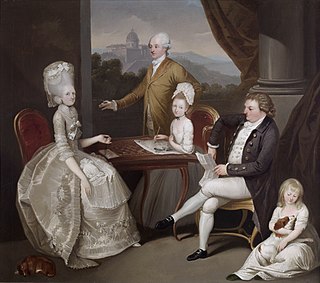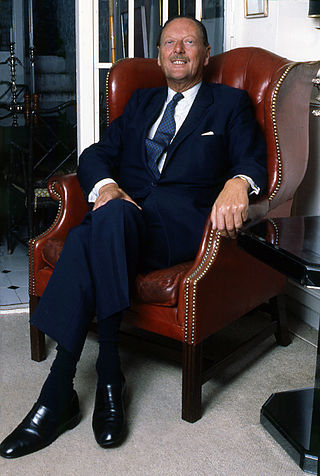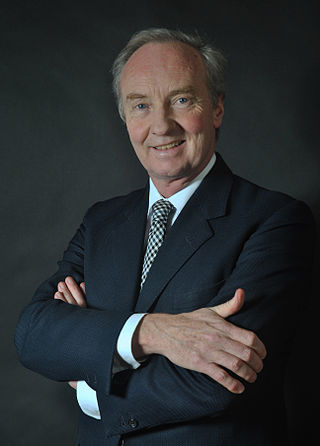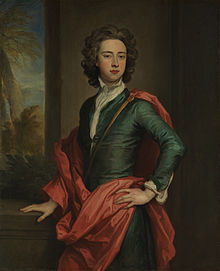
Duke of St Albans is a title in the Peerage of England. It was created in 1684 for Charles Beauclerk, 1st Earl of Burford, then 14 years old. King Charles II had accepted that Burford was his illegitimate son by Nell Gwyn, an actress, and awarded him the dukedom just as he had conferred those of Monmouth, Southampton, Grafton, Northumberland, and Richmond and Lennox on his other illegitimate sons who married.

Eleanor Gwyn was an English stage actress and celebrity figure of the Restoration period. Praised by Samuel Pepys for her comic performances as one of the first actresses on the English stage, she became best known for being a long-time mistress of King Charles II of England.

Charles Lennox, 1st Duke of Richmond, 1st Duke of Lennox, of Goodwood House near Chichester in Sussex, was the youngest of the seven illegitimate sons of King Charles II, and was that king's only son by his French-born mistress Louise de Kérouaille, Duchess of Portsmouth. He was appointed Hereditary Constable of Inverness Castle.
Charles Francis Topham de Vere Beauclerk, also styled Earl of Burford by courtesy, is a British aristocrat and heir to the peerage title of Duke of St Albans.

Murray de Vere Beauclerk, 14th Duke of St Albans,, styled Earl of Burford from 1964 until 1988, is an English duke. He was a member of the House of Lords from 1988 until 1999.
Beauclerk or Beauclerc is an English surname, from Anglo-Norman meaning "fine scholar". It is also the family name of the Duke of St Albans.

Topham Beauclerk was a celebrated English wit and a friend of Samuel Johnson and Horace Walpole.

Charles Beauclerk, 2nd Duke of St Albans, KG KB was a British politician who sat in the House of Commons from 1718 until 1726 when he succeeded to a peerage as Duke of St Albans. He was an illegitimate grandson of King Charles II.
George Beauclerk, 3rd Duke of St Albans, styled Earl of Burford until 1751, was a British peer.

Aubrey Beauclerk, 5th Duke of St Albans was a British landowner, and a collector of antiquities and works of art.

Aubrey Beauclerk, 6th Duke of St Albans was an English aristocrat and politician.
William Beauclerk, 8th Duke of St Albans was an English aristocrat.

William Amelius Aubrey de Vere Beauclerk, 10th Duke of St Albans, PC DL, styled Earl of Burford until 1849, was a British Liberal parliamentarian of the Victorian era.
Osborne de Vere Beauclerk, 12th Duke of St Albans was a British peer and Army officer. He was styled Lord Osborne Beauclerk from 1874 to 1934.

Charles Frederick Aubrey de Vere Beauclerk, 13th Duke of St Albans, OBE was a British soldier and hereditary peer.

The Reverend Lord Frederick de Vere Beauclerk, a 19th-century Anglican priest, was an outstanding but controversial English first-class cricketer, the leading "amateur" player of the Napoleonic period.

Diana Beauclerk, Duchess of St Albans, born Lady Diana de Vere, was a British courtier. She was Mistress of the Robes to Caroline, Princess of Wales from 1714 to 1717. She was one of the Hampton Court Beauties of Mary II of England.

Richard Walter John Montagu Douglas Scott, 10th Duke of Buccleuch and 12th Duke of Queensberry,, styled as Lord Eskdaill until 1973 and as Earl of Dalkeith from 1973 until 2007, is a Scottish landholder and peer. He is the Duke of Buccleuch and Queensberry, as well as Chief of Clan Scott. He is a descendant of James, Duke of Monmouth, the eldest illegitimate son of Charles II and his mistress, Lucy Walter, and more remotely in a direct male line from Alan of Dol, who arrived in Britain in 1066 with William the Conqueror.

Lord Sidney Beauclerk was a British politician who sat in the House of Commons from 1733 to 1744. He acquired a reputation as a fortune hunter.
Lord William Beauclerk was a British army officer and politician who sat in the House of Commons from 1724 to 1733.

















